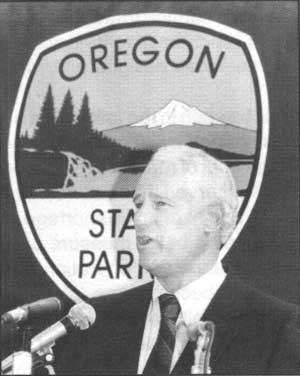|
OREGON'S HIGHWAY PARK SYSTEM: 1921-1989 An Administrative History |

|
FOREWORD
Ask Oregonians what makes their state special, and invariably state parks will be named at the top of the list. The parks system embodies some of the state's finest scenic and recreational attractions: sandy beaches and campgrounds of the coastal rain forest, areas of the broad Willamette Valley well suited for boating, picnicking and educational facilities; forest waysides and hiking trails in the Columbia Gorge and Cascade Range and spectacular river canyons of the high desert region. In addition to the recreational opportunities they provide and the beauty they allow us to enjoy, Oregon State Parks also have served as an indicator of how we are feeling about our state, and to some extent, I think, how the state encourages us to feel about ourselves as Oregonians. I have always believed that when the parks are in good repair and there is an adequate supply of parks and recreation facilities for our citizens, Oregonians feel better about themselves.
For more than 60 years we have taken memories, laughter, knowledge, a sense of heritage, and a sense of place from Oregon parks. This administrative history tells about that legacy, and it explains how we have reached the point of needing to give something back.
During my term as Governor I came to realize the parks, so well used by Oregonians and visitors, were showing signs of wear and tear. New development had been scarce since 1970, and deteriorating facilities were not keeping pace with demand. In 1980, voters restricted use of gasoline tax revenues for highways, and the Parks budget was severely reduced. Without major new funding, the bold vision, land acquisition and lofty goals that marked the early years could not possibly continue into the future. For that reason, I urged the creation of a state parks system independent of the Department of Transportation.
For many years, the Transportation Commission had directed its state parks division with the support of a dedicated State Parks and Recreation Advisory Committee. The work was carried out faithfully and well. Nevertheless, the time had come to acknowledge the new economic order and move State Parks forward. The agency needed opportunities to grow, to build for the future and to teach visitors more about Oregon history, wildlife and natural habitat.
Thanks to the bipartisan leadership of legislators such as Senator Jane Cease and Representatives John Schoon and Jim Whitty, a bill creating a separate Parks and Recreation Commission was passed by the 1989 Oregon Legislative Assembly. On August 2, 1989, State Parks celebrated 60 years as an organized agency and the beginning of a new era. On that day I signed the bill into law along with my successor, Secretary of State Barbara Roberts. Soon afterward, I had the privilege of appointing the first seven-member Parks and Recreation Commission. A wholly independent State Parks and Recreation Department is now a reality. I take pride in that achievement and in knowing that a revitalized parks system will be a wonderful reflection of pride in ourselves and our state. I remain convinced that the organization, under the guidance of its new citizen commission, will pursue its mission to "protect the best of Oregon" with ever greater success in the 1990s and beyond.
Neil Goldschmidt
Governor of Oregon
1987-1991

|
| Governor Goldschmidt addresses friends and supporters of Oregon State Parks on the front steps of the capitol during bill-signing exercises. 1989. Oregon Department of Transportation Photo #V2313-4. |
| <<< Previous | <<< Contents>>> | Next >>> |
foreword.htm
Last Updated: 06-Aug-2008